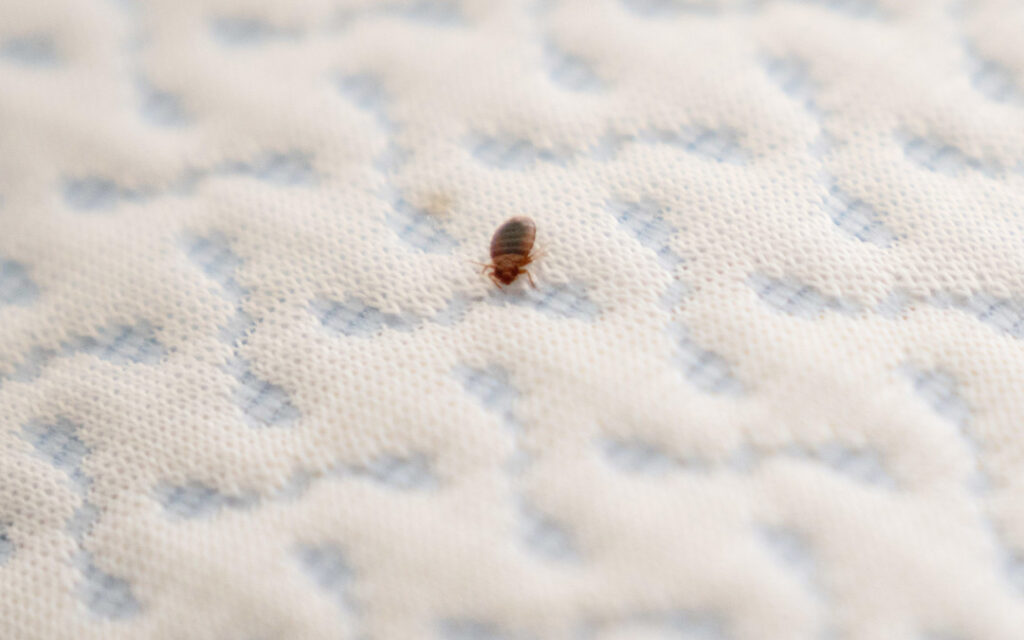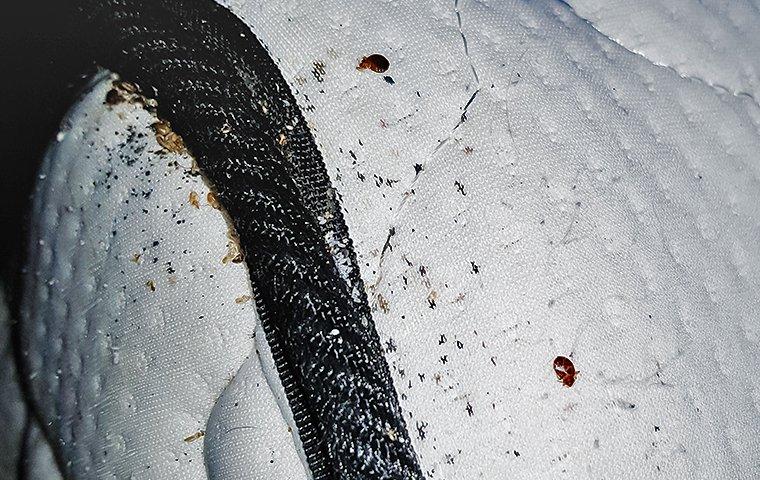If you have ever encountered bedbugs in your home, you know how frustrating it can be. Not only are they difficult to get rid of, but they can also cause itchy bites that can be quite uncomfortable.
If you’ve ever experienced bedbugs on mattress, you know how intimidating and unpleasant they can be. Now we have got the right and perfect solutions for you which will be efficient in being active for these little bedbugs.
One of the most common places for bedbugs to hide is in your mattress. In this post, we’ll explore how to deal with bedbugs on mattress and prevent them from returning. So, let’s start getting rid of bed bugs!
What are Bedbugs?
Bedbugs are tiny, flat, reddish-brown insects that feed on human blood. They are attracted to warmth, which is why they tend to infest areas where people sleep, such as beds, mattresses, and couches. They are mostly active at night and tend to hide during the day in cracks and crevices.
How to Identify Bedbugs on Mattress?
Identifying bed bugs on mattress can be a bit tricky, as they are tiny and tend to hide during the day. However, there are some signs you can look out for, such as:
- Small blood stains on the mattress or sheets
- Rusty or dark spots (excrement) on the mattress or sheets
- Bed bugs shell or skin
- A musty or sweet odor
- If you notice any of these signs, you may have a bedbug infestation on your mattress.

How to Get Rid of Bedbugs on Mattress?
Getting rid of bed bugs on mattress can be a bit challenging, but it’s not impossible. Here are some steps you can take to get rid of bed bugs on mattress:
Step 1: Inspect the Mattress
The first step in getting rid of bedbugs on a mattress is to inspect it thoroughly. Look for any signs of bed bugs, such as bloodstains, excrement, or bedbug shells. Pay close attention to the seams, buttons, and any other crevices where bed bugs may hide.
Step 2: Remove Bedding and Wash It
Once you have inspected the mattress, remove all the bedding and wash it in hot water (at least 60°C). This will kill any bed bugs, eggs, or larvae that may be hiding in the bedding.
Step 3: Vacuum the Mattress
Use a vacuum cleaner with a crevice tool to vacuum the mattress thoroughly. Pay close attention to the seams, buttons, and any other crevices where bed bugs may hide. Be sure to empty the vacuum cleaner after each use.
Step 4: Treat the Mattress
There are several ways to treat a mattress for bed bugs, such as:
Using Bedbug Sprays:
You can use best bed bug sprays to kill any bed bugs that may be hiding in the mattress. Be sure to follow the instructions carefully and use the spray in a well-ventilated area.
Using Diatomaceous Earth:
Diatomaceous earth is a natural insecticide that can be used to kill bed bugs. Sprinkle a thin layer of diatomaceous earth on the mattress, and leave it for a few days before vacuuming it up.
Using Heat Treatment:
You can use heat treatment to kill bed bugs on a mattress. Place the mattress in a sealed plastic bag and leave it in the sun for several hours, or use a specialized bedbug heat treatment device.
Step 5: Use Bedbugs Encasements
After treating the mattress, use bedbug encasements to cover it. Bedbug encasements are special covers that prevent bedbugs from infesting the mattress. Be sure to choose a high end quality encasement.

Preventing Bedbugs on Mattress
Another important aspect to consider when dealing with bedbugs on mattress is prevention. Preventing bed bugs from infesting your mattress is crucial to maintaining a healthy sleeping environment.
You can always call a bugs control company like Terminix, which holds a higher ground in this section of removing bugs. Do check out the best review on this bugs removal company.
Here are some tips to help prevent bed bugs from infesting your mattress:
Keep your Bedding Clean:
Washing your bedding frequently will help prevent bedbugs from setting up camp in your mattress. Bedbugs can’t survive high temperatures, so washing your bedding on a high heat setting can help kill any bed bugs that may be hiding in your sheets or blankets.
Use Bed Bug-Proof mattress & Box Spring Encasements:
Bed Bug-proof encasements are specially designed covers that keep bed bugs from getting into your mattress or box spring. These covers should be used on both the mattress and the box spring to ensure that bed bugs can’t get in or out.
Inspect used mattresses carefully:
If you’re thinking of buying a used mattress, be sure to inspect it carefully for any signs of bed bugs. Look for tiny blood stains, dark spots, or actual bugs themselves. If you’re not sure whether a used mattress is infested with bedbugs, it’s best to err on the side of caution and avoid buying it altogether.
Vacuum frequently:
Vacuuming your mattress and box spring regularly can help remove any bedbugs that may be hiding in the crevices of your bed. Be sure to vacuum thoroughly, paying special attention to the seams and corners of your mattress.
Seal cracks and crevices:
Bedbugs can hide in cracks and crevices around your mattress and box spring. Sealing these cracks with caulk or another type of sealant can help keep bedbugs out.
By following these tips, you can help prevent bedbugs from infesting your mattress and keep your sleeping environment clean and healthy.
Conclusion
Dealing with bedbugs on mattress can be a frustrating and unpleasant experience. However, by taking the proper steps to identify, treat, and prevent bedbug infestations, you can maintain a healthy sleeping environment and avoid the many problems associated with bedbugs.
Remember to always be vigilant and proactive when it comes to bed bug prevention, and don’t hesitate to seek professional help if you need it. With a little effort and determination, you can keep bedbugs at bay and enjoy a restful night’s sleep.
FAQs
How can you tell if a mattress has bed bugs?
Look for live bed bugs, shed skins, or small brownish-red fecal spots in the seams, crevices, and tufts of the mattress to detect bed bugs.
What kills bed bugs instantly on a mattress?
There are several ways to kill bed bugs on a mattress, but one of the most effective methods is to use a bed bug spray that contains insecticides such as pyrethroids or neonicotinoids. These sprays can kill bed bugs instantly upon contact. It’s important to follow the instructions carefully and use the spray only as directed to avoid any potential health risks.
How do you disinfect a mattress from bed bugs?
To disinfect a mattress from bed bugs, follow these steps:
1. Remove all bedding, pillows, and other items from the mattress.
2. Use a vacuum cleaner with a crevice tool to vacuum the entire surface of the mattress, paying special attention to seams, tufts, and folds where bed bugs may hide.
3. Seal the vacuum bag in a plastic bag and dispose of it in an outdoor trash can.
4. Use a bed bug spray that contains insecticides such as pyrethroids or neonicotinoids to treat the mattress and any other infested areas.
5. Let the mattress dry completely before covering it with a bed bug-proof cover.
Can a mattress with bed bugs be saved?
In most cases, a mattress with bed bugs can be saved, but it depends on the severity of the infestation and the condition of the mattress. If the infestation is severe and the mattress is old or in poor condition, it may be best to dispose of the mattress and replace it with a new one.
What is the main cause of bed bugs?
The main cause of bed bugs is human activity. Bed bugs are excellent hitchhikers and can be brought into a home on infested items such as luggage, clothing, furniture, and bedding. They can also spread from one unit to another in multi-unit dwellings such as apartments or hotels.
Bed bugs are not attracted to dirt or filth, but they are attracted to warmth, carbon dioxide, and the presence of humans, making them more common in areas where people sleep or rest for extended periods, such as beds and couches.







+ There are no comments
Add yours